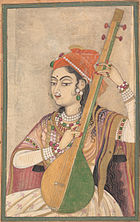Hindustani Classical Music
| Hindustani classical music | ||||||
|---|---|---|---|---|---|---|
| Concepts | ||||||
| Instruments | ||||||
|
||||||
| Genres | ||||||
|
||||||
| Thaats | ||||||
| Music of India | |
|---|---|
 A lady playing the Tanpura, c. 1735 (Rajasthan) | |
| Genres | |
Traditional
Modern | |
| Media and performance | |
| Music awards | |
| Music festivals | |
| Music media | |
| Nationalistic and patriotic songs | |
| National anthem | Jana Gana Mana |
| Regional music | |
| |
| Music of Bangladesh | |
|---|---|
 | |
| Genres | |
| Specific forms | |
| Religious music | |
| Ethnic music | |
| Traditional music | |
| Media and performance | |
| Music awards | |
| Music festivals | |
| Music media | Radio
Television Internet |
| Nationalistic and patriotic songs | |
| National anthem | Amar Shonar Bangla |
| Other | Notuner Gaan (National March) Ekusher Gaan (Ode to the Language Movement) |
| Regional music | |
| Related areas | |
| Other regions | |
Hindustani classical music is the classical music of northern regions of the Indian subcontinent. It may also be called North Indian classical music or, in Hindustani, shastriya sangeet (śāstriya saṅgīt). Its origins date from the 12th century CE, when it diverged from Carnatic music, the classical tradition of southern regions of the Indian subcontinent.[1]
History
Around the 12th century, Hindustani classical music diverged from what eventually came to be identified as Carnatic classical music. Hindustani music places more emphasis on improvisation and exploring all aspects of a raga, while Carnatic music is primarily composition-based. The central notion in both these systems is that of a melodic musical mode or raga, sung to a rhythmic cycle or tala. It is melodic music, with no concept of harmony. These principles were refined in the musical treatises Natya Shastra, by Bharata (2nd–3rd century CE), and Dattilam (probably 3rd–4th century CE).[2]
References
- ↑ "Carnatic Music | ipassio wiki". wiki.ipassio.com. Retrieved 17 March 2021.
- ↑ A Study of Dattilam: A Treatise on the Sacred Music of Ancient India, 1978, p 283, Mukunda Lāṭha, Dattila